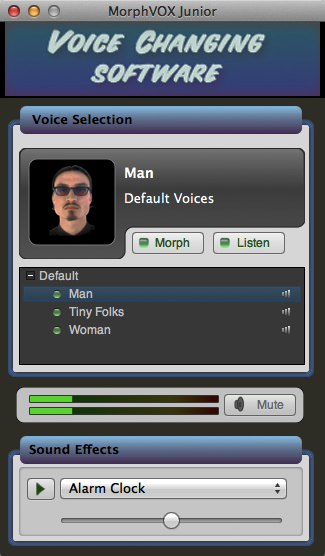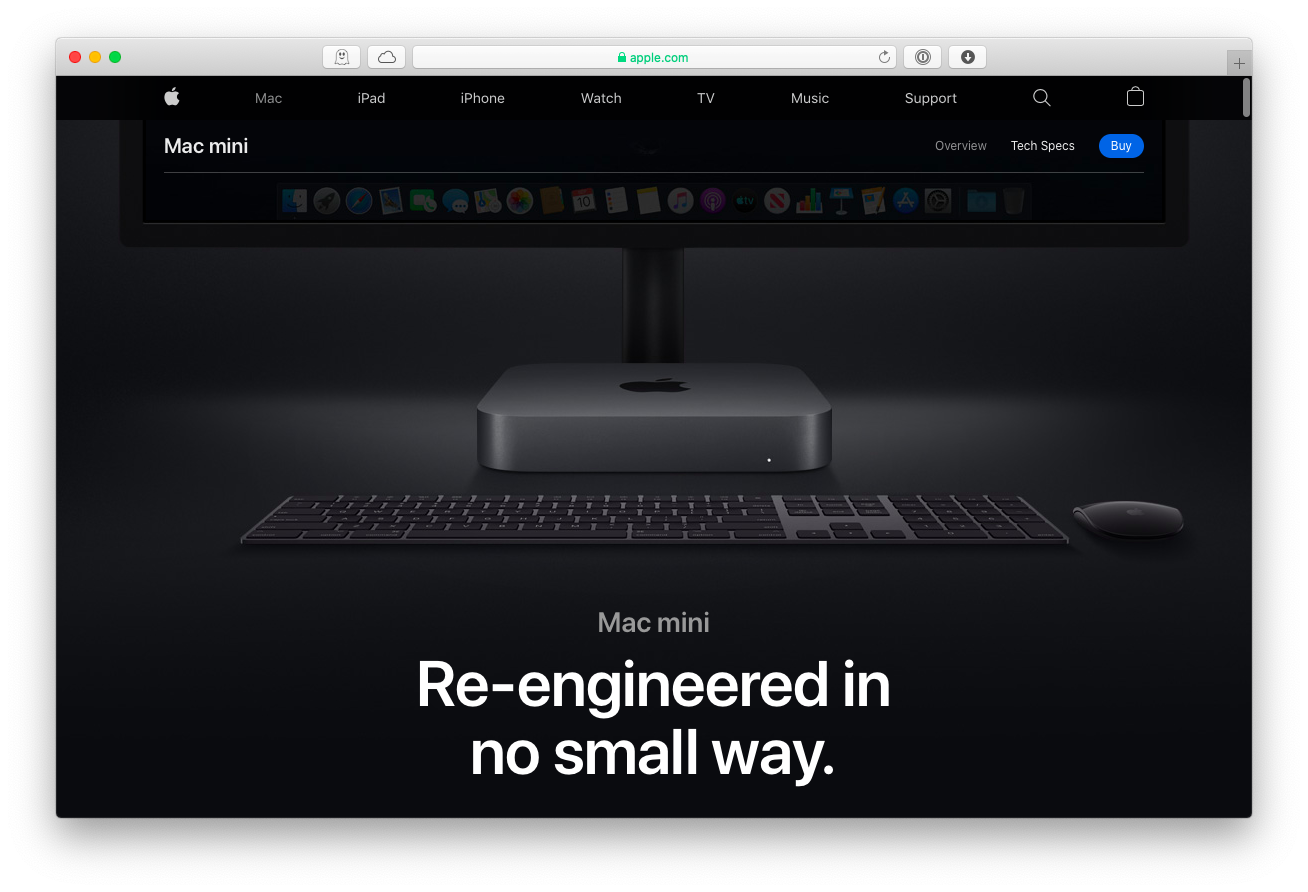Tiny Man Mac OS
EME - Open-source Markdown editor with an interface like Chrome. IA Writer - Writing app with an emphasis on simplicity and design. LightPaper - Simple, beautiful, yet powerful text editor for your Mac. MacDown - Open-source Markdown editor for OS X. Marked 2 - This is the Markdown preview with an elegant and powerful set of tools for all writers. Travel To USA for iPad, iPhone, Android, Mac & PC! Join Mark and the Hudson's on their new adventure, find hidden objects and solve challenging puzzles!! Compactible OS list: Windows 10; Windows 8.1; Windows 7; Windows Vista; Requirements for MacOS Installation. Intel, 64-bit processor, OS X 10.7 or later. Compactible OS list: OS X 10.10: Yosemite; OS X 10.11: El Capitan; macOS 10.12: Sierra; macOS 10.13: High Sierra; macOS 10.14: Mojave8; macOS 10.15: Catalina; macOS Big Sur (macOS 11).
Search for torrents and play them right in your browser. The fastest, easiest, most enjoyable way to get torrents, period. Download µTorrent Web. Having trouble installing on Mac? Find the solution here. ΜTorrent Stable (1.8.7 build 45548) For Mac (4.07 MB) English (US) - May 20, 2020.
macOS 10.13 brings changes to sysadminctl. You know those dscl scripts we used to use to create users? No longer supposed to be necessary (luckily they do still work). Now you can create a user with a one-liner, and do other forms of user management, such as enabling FileVault for a given user, or managing the guest accounts. However, you can’t do these tasks as root or via sudo. You have to do so with other admin accounts per Apple kbase HT208171 (in fact, this article has been in my queue waiting for that issue to be fixed – but keep in mind I’m not prefacing these with sudo in the below commands). In the below command, we’ll pass the -addUser option and then use -fullName to fill in the displayed name of the user, -password to send a password to the account and -hint so we can get a password hint into that attribute:sysadminctl -addUser krypted2 -fullName 'Charles Edge' -password testinguser -hint hi
The result would be as follows:
No clear text password or interactive option was specified (adduser, change/reset password will not allow user to use FDE) !
Creating user record…
Assigning UID: 503
Creating home directory at /Users/krypted2
Tiny Man Mac Os Download
Notice that in the above, the system automatically selected a home directory and UID. We could have passed those as well, using Now let’s use dscl to view the user we just created:https://coolgfile634.weebly.com/how-to-take-screen-capture-mac.html. dscl . -read /Users/krypted2
NFSHomeDirectory: /Users/krypted2
Password: ********
Picture: /Library/User Pictures/Fun/Ying-Yang.png
PrimaryGroupID: 20
RealName: Charles Edge
RecordName: krypted2
RecordType: dsRecTypeStandard:Users
UniqueID: 503
UserShell: /bin/bashNotice that the above is not the whole record you’d typically find with dscl. But if it were, you would not have the AuthenticationAuthority attribute. To see if it can unlock FileVault we can use the -secureTokenStatus operator built into sysadminctl. Simply pass the RecordName and you’ll get an indication if it’s on or off:
sysadminctl -secureTokenStatus krypted2The response should be as follows:
Secure token is ENABLED for user Charles Edge
To just get the ENABLED response we’ll just use awk to grab that position (also note that we have to redirect stderr to stdout): sysadminctl -secureTokenStatus charles.edge 2>&1 awk '{print$7}'
We could append the AuthenticationAuthority attribute with dscl, as we would need a SecureToken. To get a SecureToken, we’ll use the -secureTokenOn verb:
sysadminctl -secureTokenOn krypted mysupersecretpasswordTo disable, we’ll use -secureTokenOff
sysadminctl -secureTokenOff krypted mysupersecretpasswordTiny Man Mac Os X
Given that we like to rotate management passwords, we can do so using-resetPasswordFor which takes a username and a password as -newPassword and -passwordHint respectively:
sysadminctl -resetPasswordFor krypted -newPassword newsupersecretpassword -passwordHint 'That was then this is now'( very old)balloon buoyancy mac os.

sysadminctl -guestAccount status 2>&1 awk '{print$5}'
sysadminctl -guestAccount OffYou can also use sysadminctl to do a quick check of the encryption state of the boot volume using the -filesystem option (although there’s no on and off verb for this option just yet):
bash-3.2# sysadminctl -filesystem status
2017-12-07 10:37:26.401 sysadminctl[8534:466661] Boot volume CS FDE: NO
2017-12-07 10:37:26.434 sysadminctl[8534:466661] Boot volume APFS FDE: YES
The help page is as follows:Usage: sysadminctl [[interactive] [-adminUser -adminPassword ]] -deleteUser -oldPassword ] -resetPasswordFor -newPassword ] -addUser ] [-UID ] [-shell ] [-password ] [-home -secureTokenOn -password -guestAccount -afpGuestAccess -smbGuestAccess -automaticTime -filesystem status Pass '-' instead of password in commands above to request prompt.
Why should you switch to sysadminctl for scripts? Entitlements and I’m sure this is how mdmclient will pass management commands in the future… Why should you not? You can’t run most of it as root…TLDR; The Lenovo M720q has dimensions, performance, and capabilities almost exactly the same as the mac mini at a more affordable price. You do lose Thunderbolt 3 connectivity as well as having to use an external power supply, but the flexibility the unit gives outweighs these compromises.
Like many people, I was also waiting for Apple to update the Mac Mini. The Mac Mini was my second Apple computer (the first was the 2011 Macbook Air) and I bought it primarily because it was the cheapest mac that Apple had to offer. So it was a bit of a mix of relief and disappointment that Apple announced the Mac Mini specs – which was a really big jump from its previous incarnations – and its price, which was also a big jump from its previous incarnations.
I’ve been thinking about purchasing the Mac Mini for many days, and I’ve been trying to consider alternatives. A couple of years back I bought the Intel NUC 7i5BNH which was the very first NUC that had Thunderbolt 3 capabilities, and is really easy to hackintosh. I thought that if I were to get a new machine, it’s not gonna be an ultraportable with long battery life (I’ve already got the T480 for that), nor is it gonna be a gaming laptop (I’ve already got a Clevo P651 for that, plus I have the 1070 version), nor is it gonna be a full desktop (I’ve already got a i7-3770 that I’ve converted into an unRAID server to store old files and videos).
If I were to get a new machine, it’s gonna be either the Mac Mini, or something very similar in form factor.
Small devices with really good performance
After looking around, I found the ThinkCentre Tiny line of products by Lenovo and I was hooked. I’ve had a really good experience buying my first modern ThinkPad online, and I thought that maybe I’d go ahead and get myself one of these small form factor PCs.
I don’t have the latest Mac Mini but I was able to borrow one of the older generation Mac Mini’s from the office to have a visual comparison.
The Lenovo purchase process couldn’t be more different from that of Apple’s. Whereas the choices are quite straightforward (if not limited) with the Mac Mini:
Choose your processor, your memory, your storage, your wallet; pick three
You are given a whole boatload of choices with the ThinkCentre Tiny in comparison (and take note that that’s just one of the three possible configurations of a Tiny; there’s the M920q and the P330 models as well with their own sets of possible configurations):
How many choices do I have? Over 9000.
The ThinkCentre Tiny is so similar to the Mac Mini that it’s difficult not to make comparisons:
| mini | tiny | |
|---|---|---|
| Price | RM 3450 (USD 800) | RM 3650 (USD 810) |
| Processor | 3.6GHz quad-core Intel Core i3 6MB shared L3 cache | 2.4GHz hexa-core Intel Core i7 Turbo Boost up to 4.0GHz 12MB shared L3 cache |
| Ports | 4 thunderbolt ports 1 headphone jack 1 HDMI 2.0 1 Ethernet 2 USB-A 3.1 gen 1 | front: 1 USB-C 3.1 gen 1 1 USB-A 3.1 gen 1 1 headphone/mic combo jack 1 mic jack back: 1 Display Port 1 HDMI 2.0 2 USB-A 3.1 gen 1 2 USB-A 3.1 gen 2 1 PCIe x4 low profile (with card giving 2 USB-A 3.1 gen 1) |
| Memory | 8GB of 2666MHz DDR4 SO-DIMM memory (dual channel, as configured) | 8GB of 2666MHz DDR4 SO-DIMM memory (single channel, as configured) |
| Storage | 128GB PCIe-based SSD | 512GB NVMe SSD |
| WiFi/BT | Murata 339S00458 802.11ac BT5.0 | RealTek RTL8822BE 802.11ac BT4.2 |
| Size | 19.7cm x 19.7cm x 3.6cm | 18cm x 18.5cm x 3.6cm (bare unit) |
| Weight | 1.3kg | 1.32kg (as configured) |
Then there are those hardware and features that don’t usually make it to the spec sheets:
- The Mac Mini has an internal power supply, so all you need is a power cable. The ThinkCenter Tiny requires an external Lenovo Slim-Tip power supply. One can argue of course that having it external makes it easier to replace/repair if it breaks.
- The Mac Mini needs some specialized equipment to open so you can replace the RAM modules. The ThinkCentre Tiny doesn’t even require any tools if you configure it with the Tool-less option (which is for free by the way; I’m guessing the option to have it with tools is there for the business customers who wouldn’t want the end users to be able to open the unit without IT support).
- The Mac Mini’s SSD is non-replaceable; the ThinkCentre Tiny’s SSD is.
- Although the Mac Mini has 4 Thunderbolt 3 ports, the ThinkCenter Tiny has full PCIe capability (as long as you have the correct riser card; mine came only with a x4 riser whereas the P330 can come with a x16 riser to accommodate a low profile RX560).
- The Mac Mini comes in recycled Space Gray Aluminum. The ThinkCentre Tiny comes in Black Steel.
- The Mac Mini’s wifi antenna is internal. The ThinkCentre Tiny’s wifi antenna is external.
What is visual boy advance. No shortage of ports for both of them
My unit came with the Rambo DVD drive which increases the height a bit, but it’s optional. I’m not sure if I want to keep it inside though as it makes the whole thing a lot heavier. Then again, it was only an extra $10 or so :P
The Ramb DVD Drive adds about an extra 2cm to the height of the whole unit. It adds some VESA mount points as well.
I’ve just finished setting it up and will be running benchmarks to check for performance soon. They’re all not done yet, but the initial numbers are looking pretty good :) Piperman mac os.